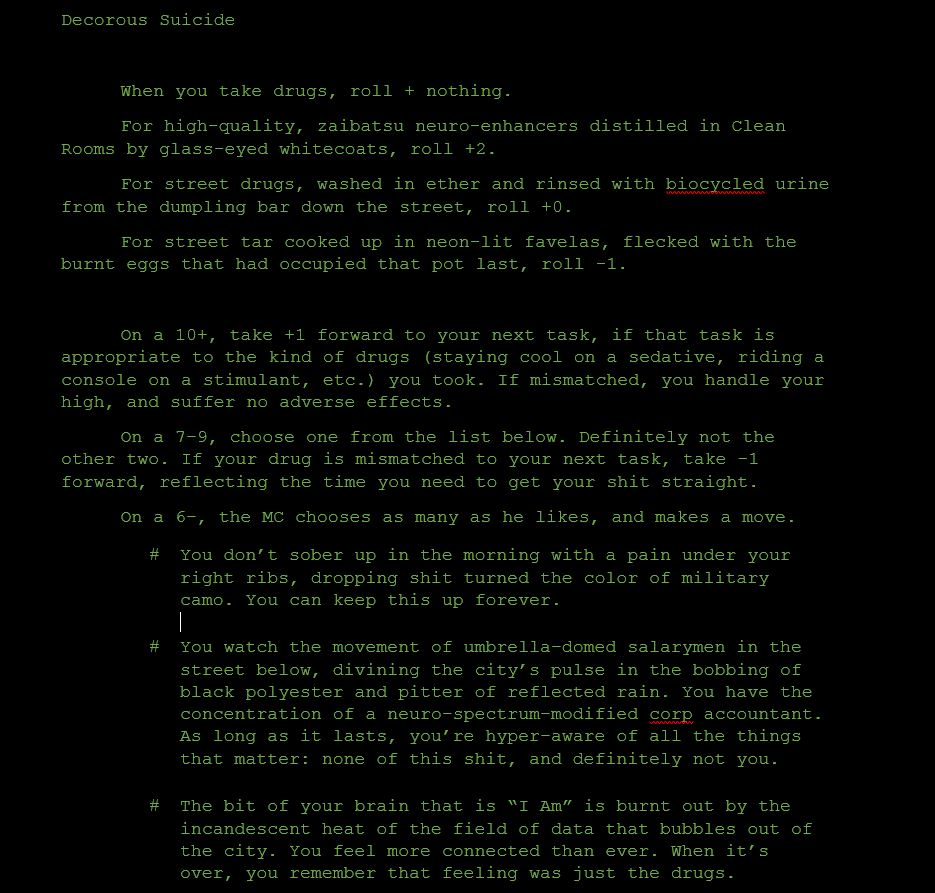Mystery vs. PbtA
In a lot of conversations, I’ve heard it ranging from implicit to explicit that part of PbtA’s narrative force has to do with not withholding narratively relevant information from players. On the contrary, players are given much more information and transparency than trad gaming, with the specific goal of enabling them to make hard/interesting choices.
Reading the City of Mist starter set made me wonder: how well does this jive with a game whose goal is to cultivate a feeling of mystery? My goal in asking this question isn’t to criticize CoM – PbTA isn’t the holy grail, and taking the mechanisms in a different direction isn’t blasphemy. The question, though, is “does PbtA work for mysteries? Does a mystery-centric build still support the pbta engine?”
CoM, in-text and in its g+ conversations, for instance, specifically calls out having players flag the direction of their interest in players’ mysteries but otherwise leaving it up to the GM (to enable the exploration of, well, mysteries). Its rules don’t really have anything with an equivalent heft of Discern Realities / Open Your Mind (though there are analogous, though it seems to me weaker, moves through Mythic intuition). The AW standard provides answers; the CoM version seeks to provide clues that prompt the exploration of more mysteries. Another example is when the player tries to push their powers – the GM explicitly hides the stakes from the player, and the player only gets to make a transparent choice on a 10+. A 7-9 is “you push, and you pay the price, w/o knowing what the price is.” A 10+ is “you get to know the price, and choose if you want to push.” It explicitly moves away from “players make narratively interesting choices” to “players go in blind.”
It seems to me that PbtA relies on a lot beyond the 2d6 tripartite outcome mechanic in order to work well, and the CoM starter pack seems to have stripped out a lot of PbtA except for that 2d6 mechanic. For instance, PbtA tends to focus a lot on “you can’t force the characters to do shit with moves, you can just carrot-and-stick them into certain decisions (e.g., no real mind control)”. CoM, otoh, has “Make a Hard Choice,” which on a fail, simply forbids you from undertaking the action you wanted to take – not failing to achieve a goal, but just outright forbidding an action. (“If you fail, your character is unable to muster the willpower to act against this aspect of herself and the MC makes a move as usual. “) Although it vaguely fits into the usual 3-part scheme of PBTA moves, it differs philosophically in that it’s not “failure to achieve a goal / suffer a complication,” because the goal you fail on is “choose to do this thing.” It forbids /the attempt/.
These decisions all seem thematically coherent to me, roughly speaking (except for the Make A Hard Move, to be honest – I get it’s the “acting against yourself” bit, but mechanically it seems off to forbid a narratively interesting action, rather than carrot-and-stick it): the goal of play in CoM doesn’t seem to be for only characters to explore mysteries, but for players to explore mysteries too. Therefore, they can indicate the sort of questions they’re interested in, but the answers aren’t going to be known to them. This seems to conflict with the sort of narrative authority that tends to define PbtA-style play, since it implies that the PCs are playing in the GM’s story, trad-style. It explicitly moves the story back into GM territory, taking player ignorance as a virtue.
Can the PbtA engine still hum in the absence of player knowledge and reduced decision-making about the story? The “players make interesting choices” mechanic would seem to be significantly mitigated here, leaving the players with a “make choices about your flags” mechanic instead. Can you construct stories in an interesting way if your input into the story has been restricted to the GM again?
Thoughts?
(Pre-emptive apologies if this reads like CoM bashing. I’m quite taken with the starter set and I’m currently a KS backer. If I wasn’t a presumptive fan, I wouldn’t be bothering to read the rules closely and trying to understand the game.)


